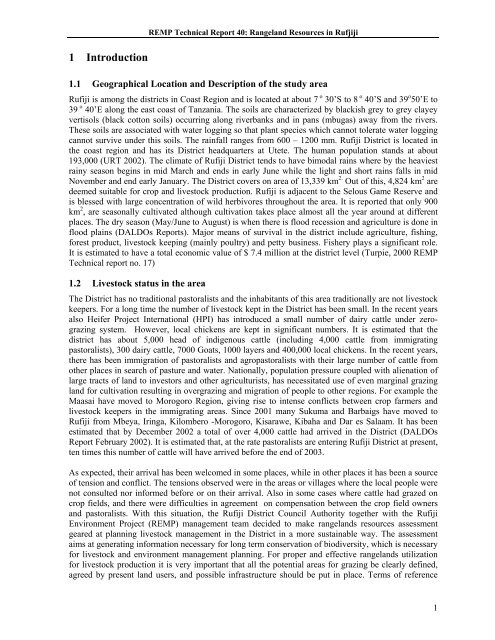rufiji environment management project - Coastal Forests of Kenya ...
rufiji environment management project - Coastal Forests of Kenya ...
rufiji environment management project - Coastal Forests of Kenya ...
You also want an ePaper? Increase the reach of your titles
YUMPU automatically turns print PDFs into web optimized ePapers that Google loves.
1 Introduction<br />
REMP Technical Report 40: Rangeland Resources in Rufjiji<br />
1.1 Geographical Location and Description <strong>of</strong> the study area<br />
Rufiji is among the districts in Coast Region and is located at about 7 o 30’S to 8 o 40’S and 39 o 50’E to<br />
39 o 40’E along the east coast <strong>of</strong> Tanzania. The soils are characterized by blackish grey to grey clayey<br />
vertisols (black cotton soils) occurring along riverbanks and in pans (mbugas) away from the rivers.<br />
These soils are associated with water logging so that plant species which cannot tolerate water logging<br />
cannot survive under this soils. The rainfall ranges from 600 – 1200 mm. Rufiji District is located in<br />
the coast region and has its District headquarters at Utete. The human population stands at about<br />
193,000 (URT 2002). The climate <strong>of</strong> Rufiji District tends to have bimodal rains where by the heaviest<br />
rainy season begins in mid March and ends in early June while the light and short rains falls in mid<br />
November and end early January. The District covers on area <strong>of</strong> 13,339 km 2. Out <strong>of</strong> this, 4,824 km 2 are<br />
deemed suitable for crop and livestock production. Rufiji is adjacent to the Selous Game Reserve and<br />
is blessed with large concentration <strong>of</strong> wild herbivores throughout the area. It is reported that only 900<br />
km 2 , are seasonally cultivated although cultivation takes place almost all the year around at different<br />
places. The dry season (May/June to August) is when there is flood recession and agriculture is done in<br />
flood plains (DALDOs Reports). Major means <strong>of</strong> survival in the district include agriculture, fishing,<br />
forest product, livestock keeping (mainly poultry) and petty business. Fishery plays a significant role.<br />
It is estimated to have a total economic value <strong>of</strong> $ 7.4 million at the district level (Turpie, 2000 REMP<br />
Technical report no. 17)<br />
1.2 Livestock status in the area<br />
The District has no traditional pastoralists and the inhabitants <strong>of</strong> this area traditionally are not livestock<br />
keepers. For a long time the number <strong>of</strong> livestock kept in the District has been small. In the recent years<br />
also Heifer Project International (HPI) has introduced a small number <strong>of</strong> dairy cattle under zerograzing<br />
system. However, local chickens are kept in significant numbers. It is estimated that the<br />
district has about 5,000 head <strong>of</strong> indigenous cattle (including 4,000 cattle from immigrating<br />
pastoralists), 300 dairy cattle, 7000 Goats, 1000 layers and 400,000 local chickens. In the recent years,<br />
there has been immigration <strong>of</strong> pastoralists and agropastoralists with their large number <strong>of</strong> cattle from<br />
other places in search <strong>of</strong> pasture and water. Nationally, population pressure coupled with alienation <strong>of</strong><br />
large tracts <strong>of</strong> land to investors and other agriculturists, has necessitated use <strong>of</strong> even marginal grazing<br />
land for cultivation resulting in overgrazing and migration <strong>of</strong> people to other regions. For example the<br />
Maasai have moved to Morogoro Region, giving rise to intense conflicts between crop farmers and<br />
livestock keepers in the immigrating areas. Since 2001 many Sukuma and Barbaigs have moved to<br />
Rufiji from Mbeya, Iringa, Kilombero -Morogoro, Kisarawe, Kibaha and Dar es Salaam. It has been<br />
estimated that by December 2002 a total <strong>of</strong> over 4,000 cattle had arrived in the District (DALDOs<br />
Report February 2002). It is estimated that, at the rate pastoralists are entering Rufiji District at present,<br />
ten times this number <strong>of</strong> cattle will have arrived before the end <strong>of</strong> 2003.<br />
As expected, their arrival has been welcomed in some places, while in other places it has been a source<br />
<strong>of</strong> tension and conflict. The tensions observed were in the areas or villages where the local people were<br />
not consulted nor informed before or on their arrival. Also in some cases where cattle had grazed on<br />
crop fields, and there were difficulties in agreement on compensation between the crop field owners<br />
and pastoralists. With this situation, the Rufiji District Council Authority together with the Rufiji<br />
Environment Project (REMP) <strong>management</strong> team decided to make rangelands resources assessment<br />
geared at planning livestock <strong>management</strong> in the District in a more sustainable way. The assessment<br />
aims at generating information necessary for long term conservation <strong>of</strong> biodiversity, which is necessary<br />
for livestock and <strong>environment</strong> <strong>management</strong> planning. For proper and effective rangelands utilization<br />
for livestock production it is very important that all the potential areas for grazing be clearly defined,<br />
agreed by present land users, and possible infrastructure should be put in place. Terms <strong>of</strong> reference<br />
1

















